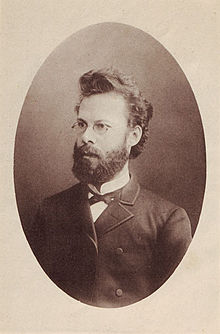bio.wikisort.org - Researcher
Johannes Theodor Schmalhausen (1849–1894) was a Russian botanist of German descent, known for his studies of East-European plants.[1][2][3]
This article may be expanded with text translated from the corresponding article in Russian. (May 2010) Click [show] for important translation instructions.
|
Johannes Theodor Schmalhausen | |
|---|---|
 Johannes Theodor Schmalhausen | |
| Born | 1849 |
| Died | 1894 |
| Known for | Flora yugo-zapadnoj Rossii (1886) Flora sredney i yuzhnoj Rossii, Kryma i Severnogo Kavkaza[1] (1895-1897) |
| Scientific career | |
| Fields | Botanist |
| Signature | |
Early life and education
Johannes Theodor Schmalhausen was born in St Petersburg. His father was a librarian at the Russian Academy of Sciences. After attending the Gymnasium, Schmalhausen studied botany at the University of St. Petersburg graduating with a magister degree in 1874. He was awarded the Gold Medal of the University for the botanical essay "On plant hybrids. Observations from St. Petersburg", was selected for a Professorial career and sent abroad from 1874 to 1876. He studied in Strasbourg (with Heinrich Anton de Bary and Andreas Franz Wilhelm Schimper), Zurich (with Oswald Heer), Vienna, Prague, Munich, Berlin, visited the Alps, Northern Italy and Southern France.
In 1877 he became a conservator at the herbarium of the Imperial Botanical Garden in Saint Petersburg and was ordained as a professor (Russian doctorate).
Career
From 1878 he was associate professor at Vladimir University of Kiev and later professor of botany. For several years he was director of the botanical garden at the University of Kiev.
His youngest son was the evolutionary biologist Ivan Schmalhausen.
Legacy
The genus Schmalhausenia (family Asteraceae) is named in his honor.[4]
Published works
- Beiträge zur Kenntnis der Milchsaftbehälter der Pflanzen, 1877.
- Beiträge zur Jura-Flora Russlands, 1879.
- Beiträge zur Tertiärflora Süd-West-Russlands, 1883.
- Tertiäre Pflanzen der Insel Neusibirien, 1890.[5]
References
- HUH Publications Index
- Herbarium of vascular plants of National Herbarium of Ukraine: general information Archived 2010-01-28 at the Wayback Machine
- HUH Botanists Index
- Biodiversity Heritage Library Taxonomic literature : a selective guide to botanical publications
- Works by or about Johannes Theodor Schmalhausen in libraries (WorldCat catalog)
- IPNI. Schmalh.
External links
 Media related to Ivan Fedorovich Schmalhausen at Wikimedia Commons
Media related to Ivan Fedorovich Schmalhausen at Wikimedia Commons- Works by or about Johannes Theodor Schmalhausen in libraries (WorldCat catalog)
- Works by or about Ivan Fedorovych Shmalʹhauzen in libraries (WorldCat catalog)
На других языках
- [en] Johannes Theodor Schmalhausen
[ru] Шмальгаузен, Иван Фёдорович
Ива́н Фёдорович Шмальга́узен (3 [15] апреля 1849, Санкт-Петербург[1] — 7 [19] апреля 1894, Киев[1]) — русский учёный-ботаник, член-корреспондент Санкт-Петербургской АН (с 1893), профессор Киевского университета (с 1878).Другой контент может иметь иную лицензию. Перед использованием материалов сайта WikiSort.org внимательно изучите правила лицензирования конкретных элементов наполнения сайта.
WikiSort.org - проект по пересортировке и дополнению контента Википедии